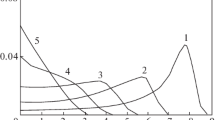Abstract
In order to analyze muon flux variations caused by extra-atmospheric processes, it is necessary to introduce corrections for meteorological effects. To take the temperature effect into account, we must know the temperature profile of the atmosphere. Vertical temperature profiles obtained from NOAA satellites and calculated using the model of the Global Data Assimilation System (GDAS) are compared to data from the Central Aerological Observatory (CAO, Dolgoprudny) for standard isobaric levels. The average temperature difference for most levels does not exceed 1 K. A comparison of the data from the URAGAN hodoscope, corrected for the temperature effect using data from the CAO, NOAA, and GDAS, shows excellent mutual agreement. A series of integral time counting rate and the anisotropy of the muon flux for 2007–2014, corrected for atmospheric effects, are presented.
Similar content being viewed by others
References
Barbashina, N.S., et al., Instr., 2008, Vol. 51, No. 2, p. 180.
Dorman, L.I., Meteorologicheskie effekty kosmicheskikh luchei (Meteorological Effects of Cosmic Rays), Moscow: Nauka, 1972.
Dmitrieva, A.N., et al., Astropart. Phys., 2011, vol. 34, p. 401.
Glagolev, Yu.A., Spravochnik po fizicheskim parametram atmosfery (Physical Parameters of Atmosphere. Handbook), Leningrad: Gidrometeoizdat, 1970.
Central Aerological Observatory. http://www.aerology.org/
Department of Atmospheric Science of University of Wyoming. http://weather.uwyo.edu/
NOAA Air Resources Laboratory (ARL), Tech. Rep., 2004. http://ready.arl.noaa.gov/gdas1.php
NOAA Satellites. http://www.noaa.gov/satellites.html
Shutenko, V.V., et al., Geomagn. Aeron., 2013, vol. 53, no. 5, p. 571.
Author information
Authors and Affiliations
Corresponding author
Additional information
Original Russian Text © A.N. Dmitrieva, N.S. Barbashina, A.A. Kovylyaeva, D.V. Chernov, V.V. Shutenko, E.I. Yakovleva, I.I. Yashin, 2015, published in Izvestiya Rossiiskoi Akademii Nauk. Seriya Fizicheskaya, 2015, Vol. 79, No. 3, pp. 417–419.
About this article
Cite this article
Dmitrieva, A.N., Barbashina, N.S., Kovylyaeva, A.A. et al. Correcting data from the URAGAN muon hodoscope for the temperature profile of the atmosphere, using data from the CAO, GDAS, and ALISA-SK receiving station for 2007–2014. Bull. Russ. Acad. Sci. Phys. 79, 383–385 (2015). https://doi.org/10.3103/S1062873815030156
Published:
Issue Date:
DOI: https://doi.org/10.3103/S1062873815030156



